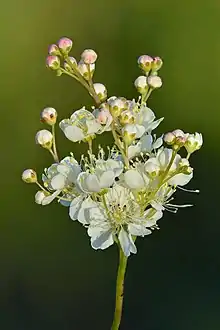| Dropwort | |
|---|---|
 | |
| Inflorescence | |
| Scientific classification | |
| Kingdom: | Plantae |
| Clade: | Tracheophytes |
| Clade: | Angiosperms |
| Clade: | Eudicots |
| Clade: | Rosids |
| Order: | Rosales |
| Family: | Rosaceae |
| Genus: | Filipendula |
| Species: | F. vulgaris |
| Binomial name | |
| Filipendula vulgaris | |
| Synonyms[1] | |
|
List
| |
Filipendula vulgaris, commonly known as dropwort or fern-leaf dropwort, is a perennial herbaceous plant in the family Rosaceae, closely related to meadowsweet (Filipendula ulmaria). It is found in dry pastures across much of Europe and central and northern Asia, mostly on lime.
The crushed leaves and roots have a scent of the oil of wintergreen (methyl salicylate).
Taxonomy and naming
The genus name Filipendula comes from Latin filum ("thread") and pendulus ("hanging") in reference to the root tubers that hang from the roots in some species. The specific epithet vulgaris means "common". The English name "dropwort" comes from the tubers that hang like drops from the root.
Description
It has finely-cut, fern-like radical leaves which form a basal rosette, and an erect stem 20–50 centimetres (8–20 in) tall[2] bearing a loose terminal inflorescence of small creamy white flowers. The flowers appear in dense clusters from late spring to midsummer atop sparsely leafed stems about 30 cm tall.
This plant prefers full sun or partial shade. It is more tolerant of dry conditions than most other members of its genus. It is a perennial of chalk and limestone downs and on heaths on other basic rocks.
Cultivation
Propagation is by seed and the division of the creeping roots. The tuberous roots and young leaves can be cooked as a vegetable or eaten raw as a salad. The taste is bitter sweet. The mature leaves smell of oil of wintergreen when crushed, due to the release of methyl salicylate.[3]
_Filipendula_vulgaris_-_Habit.jpg.webp) Habitat
Habitat Illustration showing tubers
Illustration showing tubers
References
- ↑ The Plant List: A Working List of All Plant Species, retrieved 22 May 2016
- ↑ C. A. Stace, Interactive Flora of the British Isles, a Digital Encyclopaedia: Filipendula vulgaris. ISBN 90-75000-69-3. (Online version) Archived 2011-06-08 at the Wayback Machine
- ↑ Dropwort Wildflower finder UK, RW Darlington. Accessed July 2013